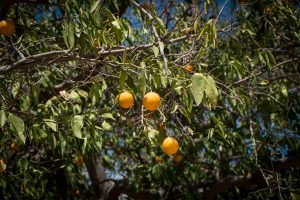
abandoned orange grove on the banks of the Colorado River, Baja California, March 27, 2014
Carey McWilliams said this about the life of the orange tree and those who grew it:
With its rich black-green shade, its evergreen foliage, and its romantic fragrance, it is the millionaire of all the trees of America…. The aristocrat of the orchards, it has, by a natural affinity drawn to it the rich and the well-born, creating a unique type of rural-urban aristocracy. There is no crop in the whole range of American agriculture the growing of which confers quite the same status that is associated with ownership of an orange grove.
(McWilliams, Southern California, an Island on the Land, as quoted in Matt Garcia’s A World of Its Own: Race, Labor, and Citrus in the Making of Greater Los Angeles, 1900-1970.)
Citrus begs tending and rewards it mightily. It is said (and I will look this up for you before I put it in a book, but it is repeated often enough that it is a point with at least literary merit, if not journalistic) that for a time in the late 19th and early 20th century Riverside, California, at the eastern end of the Southern California citrus belt, was per capita the richest place in the United States.

oranges, Baja, March 2014
Following the dry bed of the Colorado River into Mexico back in 2014, Karl Flessa led us to the little citrus ranch you see in the picture above. It seemed abandoned, but not so long ago that you could not see the traces of its old aristocracy, elegant palms lining the driveway, flanked by citrus spreading across the desert flats. It was hard to tell how long it had been since the trees were irrigated. They were spindly and dry, but the fruit pushed through anyway.
The riverbed there was dry too, covered in salt cedar. The entire space felt abandoned, but only recently so, the palms and ditch and orange trees a trace of the way water and farming still shape the place.

Beautiful piece, and well timed for the abundant citrus season in the southwest.